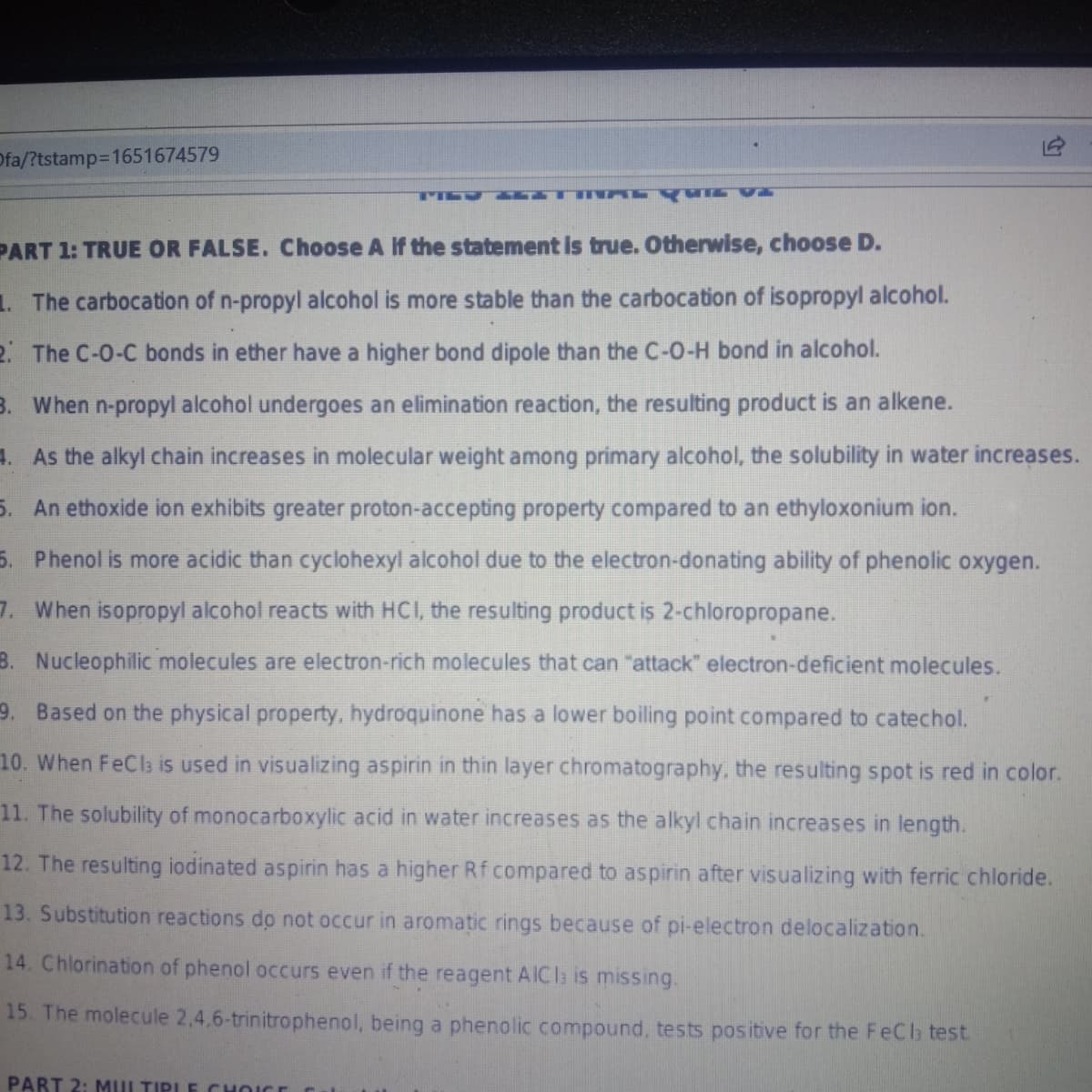Ofa/?tstamp3D1651674579 PART 1: TRUE OR FALSE. Choose A If the statement is true. Otherwise, choose D. 1. The carbocation of n-propyl alcohol is more stable than the carbocation of isopropyl alcohol. 2. The C-0-C bonds in ether have a higher bond dipole than the C-0-H bond in alcohol. 3. When n-propyl alcohol undergoes an elimination reaction, the resulting product is an alkene. 4. As the alkyl chain increases in molecular weight among primary alcohol, the solubility in water increases. 5. An ethoxide ion exhibits greater proton-accepting property compared to an ethyloxonium ion. 5. Phenol is more acidic than cyclohexyl alcohol due to the electron-donating ability of phenolic oxygen. 7. When isopropyl alcohol reacts with HCI, the resulting product is 2-chloropropane. B. Nucleophilic molecules are electron-rich molecules that can "attack" electron-deficient molecules. 9. Based on the physical property, hydroquinone has a lower boiling point compared to catechol. 10. When FeCla is used in visualizing aspirin in thin layer chromatography, the resulting spot is red in color. 11. The solubility of monocarboxylic acid in water increases as the alkyl chain increases in length. 12. The resulting iodinated aspirin has a higher Rf compared to aspirin after visualizing with ferric chloride. 13. Substitution reactions do not occur in aromatic rings because of pi-electron delocalization. 14. Chlorination of phenol occurs even if the reagent AICIa is missing. 15. The molecule 2,4,6-trinitrophenol, being a phenolic compound, tests positive for the FeCl: test. PART 2: MULTIRLE CHOICE
Ofa/?tstamp3D1651674579 PART 1: TRUE OR FALSE. Choose A If the statement is true. Otherwise, choose D. 1. The carbocation of n-propyl alcohol is more stable than the carbocation of isopropyl alcohol. 2. The C-0-C bonds in ether have a higher bond dipole than the C-0-H bond in alcohol. 3. When n-propyl alcohol undergoes an elimination reaction, the resulting product is an alkene. 4. As the alkyl chain increases in molecular weight among primary alcohol, the solubility in water increases. 5. An ethoxide ion exhibits greater proton-accepting property compared to an ethyloxonium ion. 5. Phenol is more acidic than cyclohexyl alcohol due to the electron-donating ability of phenolic oxygen. 7. When isopropyl alcohol reacts with HCI, the resulting product is 2-chloropropane. B. Nucleophilic molecules are electron-rich molecules that can "attack" electron-deficient molecules. 9. Based on the physical property, hydroquinone has a lower boiling point compared to catechol. 10. When FeCla is used in visualizing aspirin in thin layer chromatography, the resulting spot is red in color. 11. The solubility of monocarboxylic acid in water increases as the alkyl chain increases in length. 12. The resulting iodinated aspirin has a higher Rf compared to aspirin after visualizing with ferric chloride. 13. Substitution reactions do not occur in aromatic rings because of pi-electron delocalization. 14. Chlorination of phenol occurs even if the reagent AICIa is missing. 15. The molecule 2,4,6-trinitrophenol, being a phenolic compound, tests positive for the FeCl: test. PART 2: MULTIRLE CHOICE
Organic Chemistry
8th Edition
ISBN:9781305580350
Author:William H. Brown, Brent L. Iverson, Eric Anslyn, Christopher S. Foote
Publisher:William H. Brown, Brent L. Iverson, Eric Anslyn, Christopher S. Foote
Chapter2: Alkanes And Cycloalkanes
Section: Chapter Questions
Problem 2.64P
Related questions
Question
100%

Transcribed Image Text:Ofa/?tstamp3D1651674579
PART 1: TRUE OR FALSE. Choose A If the statement is true. Otherwise, choose D.
1. The carbocation of n-propyl alcohol is more stable than the carbocation of isopropyl alcohol.
2. The C-0-C bonds in ether have a higher bond dipole than the C-0-H bond in alcohol.
B. When n-propyl alcohol undergoes an elimination reaction, the resulting product is an alkene.
4. As the alkyl chain increases in molecular weight among primary alcohol, the solubility in water increases.
5. An ethoxide ion exhibits greater proton-accepting property compared to an ethyloxonium ion.
5. Phenol is more acidic than cyclohexyl alcohol due to the electron-donating ability of phenolic oxygen.
7. When isopropyl alcohol reacts with HCI, the resulting product is 2-chloropropane.
B. Nucleophilic molecules are electron-rich molecules that can "attack" electron-deficient molecules.
9. Based on the physical property, hydroquinone has a lower boiling point compared to catechol.
10. When FeCla is used in visualizing aspirin in thin layer chromatography, the resulting spot is red in color.
11. The solubility of monocarboxylic acid in water increases as the alkyl chain increases in length.
12. The resulting iodinated aspirin has a higher Rf compared to aspirin after visualizing with ferric chloride.
13. Substitution reactions do not occur in aromatic rings because of pi-electron delocalization.
14. Chlorination of phenol occurs even if the reagent AICIa is missing.
15. The molecule 2,4,6-trinitrophenol, being a phenolic compound, tests positive for the FeCla test.
PART 2: MULTIPLE CHOICE
Expert Solution
This question has been solved!
Explore an expertly crafted, step-by-step solution for a thorough understanding of key concepts.
This is a popular solution!
Trending now
This is a popular solution!
Step by step
Solved in 2 steps with 1 images

Knowledge Booster
Learn more about
Need a deep-dive on the concept behind this application? Look no further. Learn more about this topic, chemistry and related others by exploring similar questions and additional content below.Recommended textbooks for you

Organic Chemistry
Chemistry
ISBN:
9781305580350
Author:
William H. Brown, Brent L. Iverson, Eric Anslyn, Christopher S. Foote
Publisher:
Cengage Learning

Organic Chemistry
Chemistry
ISBN:
9781305580350
Author:
William H. Brown, Brent L. Iverson, Eric Anslyn, Christopher S. Foote
Publisher:
Cengage Learning